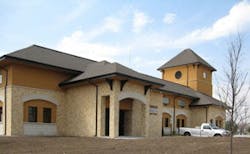Located 39 miles northwest of Wichita, the city of Hutchinson, Kan., has a population of more than 40,000. The public water supply is derived from groundwater through 20 municipal wells, most of which have been installed and maintained by Layne Christensen Co.
The city discovered that carbon tetrachloride and other volatile organic compounds (VOCs) had contaminated one of its well sites. Furthermore, high levels of inorganic chlorides (salts) were present. VOCs are typically treated by air stripping, but this strategy was complicated by the chlorides, which cannot be removed through air-stripping processes.
Strategic Solutions
An engineering firm, Professional Engineering Consultants, was brought in to devise a treatment strategy. The facility it created treats water from the contaminated well, removing iron and manganese with manganese dioxide pressure filters and removing chlorides through reverse osmosis (RO). It then removes remaining CO2 and VOCs in a degasifier concealed in the clock tower. The resulting clean water is then blended with city water, resulting in a peak production capability of 10 million gal per day (mgd).
In June 2007, Layne Christensen Co. was awarded a contract by the general contractor, Walters Morgan Construction, to assist in the design and fabrication of an RO system with a peak capacity of 6 mgd. The contract included 5-micron cartridge filters, clean-in-place equipment and chemical feed equipment for the membranes.
System Specifics
The four RO skids were fabricated in Layne’s Lakeland, Fla., manufacturing facility, while chemical feed equipment was fabricated in Layne’s Kansas City, Kan., facility. The systems includes four RO trains comprised of 24-by-12 7M arrays using Hydranautics ESPA 2 membranes. Each train is capable of producing 1.5 mgd of permeate from 2 mgd of influent. Combined, the RO trains provide the requisite 6 mgd of RO water from 8 mgd of feed. Layne was also contracted to provide startup and training in the operation of the RO system, the 5-micron cartridge prefilters, the clean-in-place equipment, the degasifier and the chemical feed equipment.
The RO system was completed in April 2009. As a result of the new facility, the city has water that is significantly cleaner and softer than the previous supply while recovering water that would otherwise have been unusable. For its innovation and commitment to its residents, the city of Hutchinson received the 2008 Drinking Water State Revolving Fund Award and the 2008 Clean Water State Revolving Fund (PISCES) Award.
Photos courtesy of Jim Perkins, Walters Morgan Construction.


